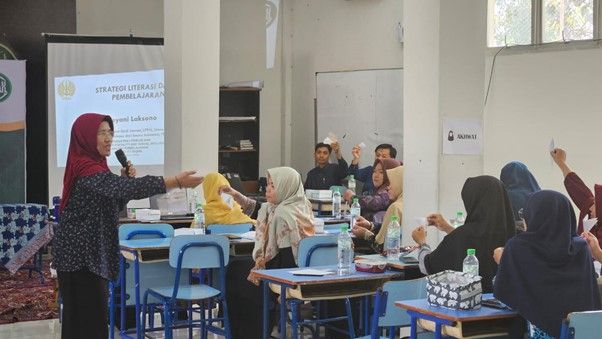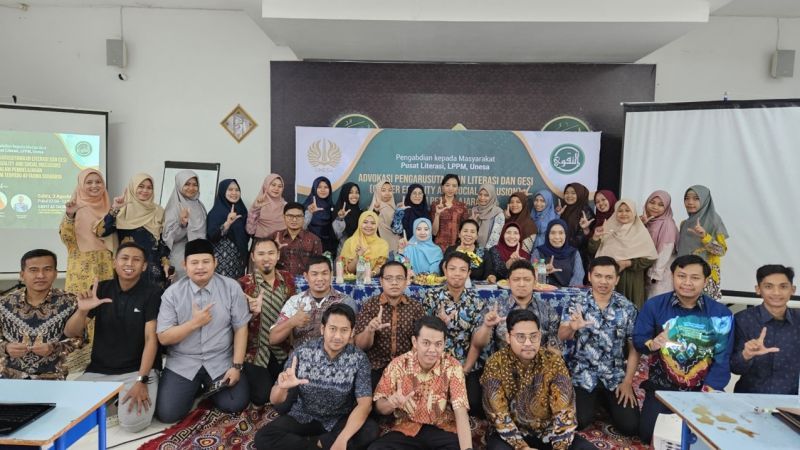
FBS professor and Head of UNESA Literacy Center provides reinforcement regarding literacy strategies in learning.
Unesa. ac.id, SURABAYA–Center for Literacy Studies, Institute for Research and Community Service (LPPM) Surabaya State University (Unesa) held Advocacy for Mainstreaming Literacy and GESI (Gender Equality and Social Inclusion) in August (3/8/2024) at the Integrated Islamic Middle School At-Taqwa, Surabaya.
Head of the LPPM UNESA Literacy Center, Kisyani Laksono, in this activity delivered material on Literacy Strategies in Learning. This is important to convey because there are many worrying factors such as low literacy skills and learning gaps after the Covid-19 pandemic.
The professor at the Faculty of Languages and Arts (FBS) emphasized that literacy is not a subject, but a type of skill. thinking or competence as well as character, numeracy, and creative and collaborative life skills. So strategies are needed in teaching literacy to students.
The aim is to build students' understanding, writing skills and overall communication skills. Then it forms students who are able to think critically, have characteristics and solve problems.
Literacy Strategy
The strategy used is to make and evaluate predictions, create visualizations and ask. Then make connections, identify, make inferences and evaluate.
The literacy strategy is carried out based on the application of learning that develops metacognitive abilities in 8 aspects. This includes monitoring text comprehension where students record their understanding before, during, and after reading.
Then secondly, using various modes during learning, providing clear and explicit instructions, and utilizing tools such as graphic organizers or checklist.
Fifth, respond to various types of questions asked by students, and provide questions to students. Seventh, students are directed to analyze, synthesize, evaluate and summarize the contents of the text.
"Literacy strategies need to be modeled many times with various types of text until students can do it themselves," said the lecturer at the Faculty of Languages and Arts.
In line with this, in his material Kisyani added that one of the keys to successful implementation of literacy strategies is choosing the most necessary strategies to help improve students' understanding of the text.
< img alt="UNESA LPPM PKM Team together with At-Taqwa Integrated Islamic Middle School, Surabaya." src="/images/foto-09-08-2024-02-12-52-3749.png" style="height:518px; width:800px" />
Application of GESI
In the material session, Yuni Lestari conveyed her understanding of the main concepts of GESI in learning. Among other things, increasing awareness of equal rights, responsibilities and equal opportunities between men and women.
Apart from that, GESI has a concept to increase awareness of the dignity of society and the independence of individuals from all social groups, as capital to achieve a better quality of life.
Meanwhile for social inclusion, he said that it was important to implement it to build social relationships and respect individuals and communities. Then to enjoy standards of welfare that are considered appropriate within the community group.
In social inclusion he said there are several things that need to be understood in terms of poverty, welfare, development measures and happiness. All of this includes three aspects which include life satisfaction, namely in the form of freedom to express one's spirituality.
Then comfort and joy as a citizen, and social acceptance of a community group. "Our goal of PKM is to realize GESI-based learning in every line of education," he said.
Not only that, the State Administration lecturer also discussed children's perspectives on gender, children's daily lives in school and at home which indirectly interacts with the opposite sex, to the introduction of gender roles for teenagers.
Apart from that, he conveys the concept of sex, the difference between gender and sex, incorrect statements regarding the meaning of nature/destiny, and several matters regarding gender inequality which include marginalization, subordination and stereotypes.

The UNESA LPPM PKM Team together with teachers at At-Taqwa Integrated Islamic Middle School, Surabaya.
Differentiated Learning
In another material, Riki Nasrullah spoke about differentiated learning. The lecturer at the Faculty of Languages and Arts explained that differentiated learning is a comprehensive and flexible process that includes planning, preparation and delivery of teaching to accommodate the diversity of students' learning needs in the classroom.
Through differentiated learning, teachers consider who they are teach, what they teach, where they teach, and how they teach. In practice, added Riki, differentiated learning must be rooted in assessment. Namely a formative assessment that allows education to get to know students better.
The aim of differentiated learning is to develop skills in planning, preparing and implementing differentiated learning. Apart from that, this method encourages continuous reflection and adjustments in teaching to accommodate the diversity of students.
"The aim of differentiated learning is to understand educators in order to achieve learning targets better," he said.[]
***Reporter: Putra (FBS)
Editor: @zam*
Photo: UNESA LPPM PKM Team
Share It On:






